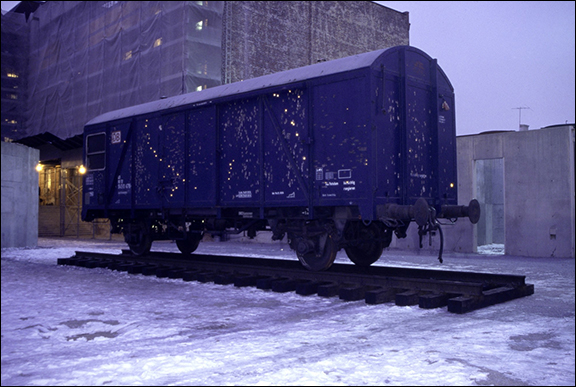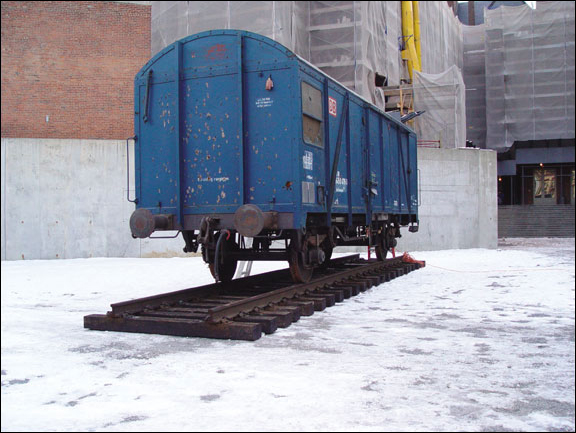Yoko Ono’s Freight Train at P.S. 1
Freight Train
A work of atonement
for the injustice and pain
we’ve experienced
in this century,
expressing resistance,
healing and hope
for the future.
Autumn, 1999 yoko ono

Yoko Ono’s Freight Train, a German boxcar riddled with bullet holes, confronts visitors as they cross the interior courtyard of P.S.1. The effect is particularly stark against the snow which covers the ground. Atop the snow is a short segment of railroad track on which rests Ono’s freight car. Its glass windows have been shattered by gunfire and myriad holes perforate the surface of the train, stripping blue paint to steel and creating a thousand voids. From inside the train, a powerful light emanates, casting luminous rays through each bullet hole and a hatch on top of the car. From the train, a music carries outward, plaintive and ghostly, evoking the fear, pain, and sadness of spirits trapped within.

Ono’s inspiration for the work came from a group of Mexican immigrants who sought clandestine passage into the United States in a freight car. They all perished when their transporters abandoned the train in the American desert. The work was first exhibited in Berlin in 2000 where it raised controversy. As a specifically German freight car, covered with German writing, it invoked memories of the holocaust and deportation trains that transported Jews and others to such death factories as Auschwitz and Treblinka. There have of course been many Freight Trains since the holocaust all over the world. As a place of confined suffering, the World Train Center in its final hours became another Freight Train as did the homes of civilians that were bombed in Afghanistan in the subsequent war. But even in the darkness there is light. The most seemingly meaningless acts of violence can serve to raise consciousness and ultimately Freight Trains could cede to a recognition of mutual dependence.

The issue of atonement which Ono raises has been problematic for some viewers. A holocaust survivor with whom I discussed the piece was particularly troubled by the way in which atonement seemed to imply universal culpability. Are the victims to atone together with their persecutors? I believe that YOKO ONO wishes for her viewers to address negative emotion which leads to hatred and violence in the world within themselves. We live in troubled times and if we are to overcome the fear, anger, and cruelty that is plaguing our society, we must first confront its ugliness and then transform it. By filling the bullet holes with light, YOKO ONO effects an alchemical transformation from base violence to illuminated consciousness. By using the word atonement, I believe YOKO ONO intends for us to confront our own interior demons. By acknowledging these demons, we can begin the difficult task of overcoming the negative influence they exert on us. By way of individual interior growth, the world becomes a more peaceful and humane place. A Buddhist proverb admonishes, “Turn the poison into medicine!
© 2003 Daniel Rothbart. All rights reserved.